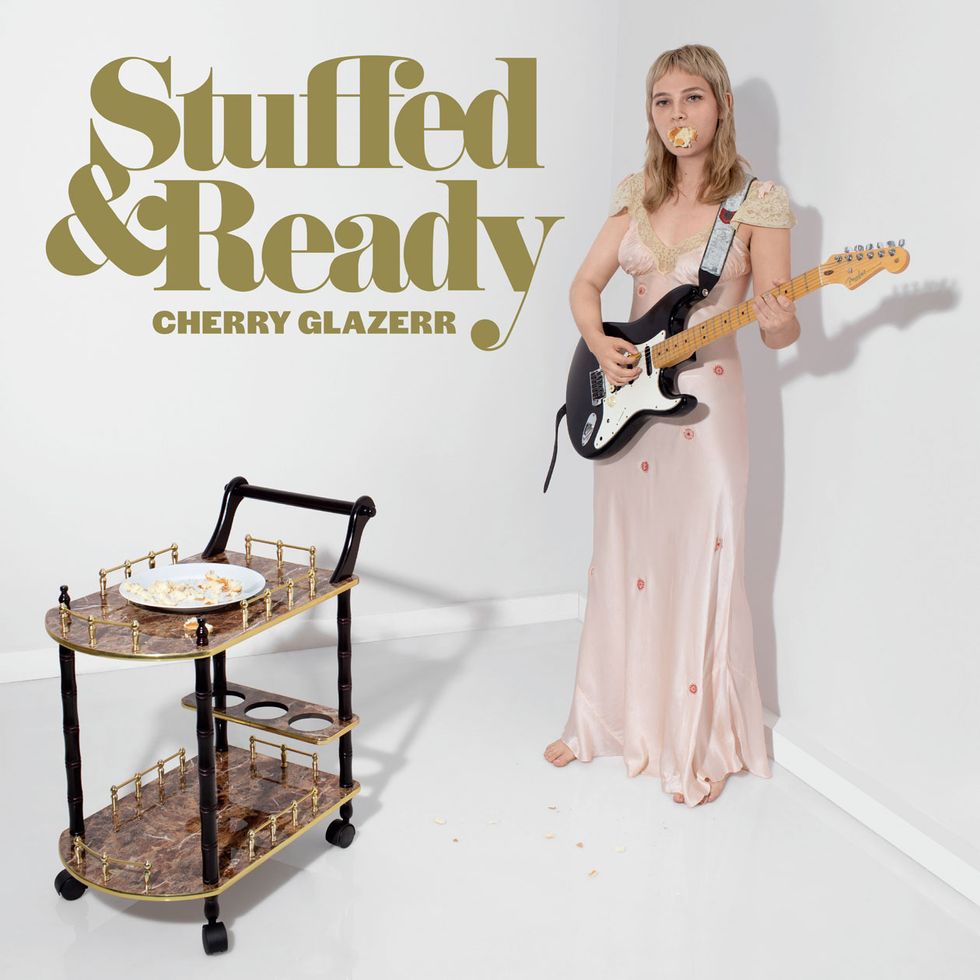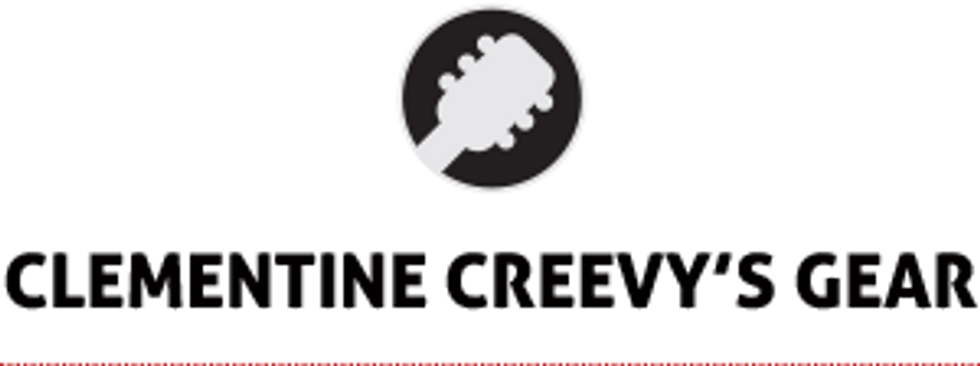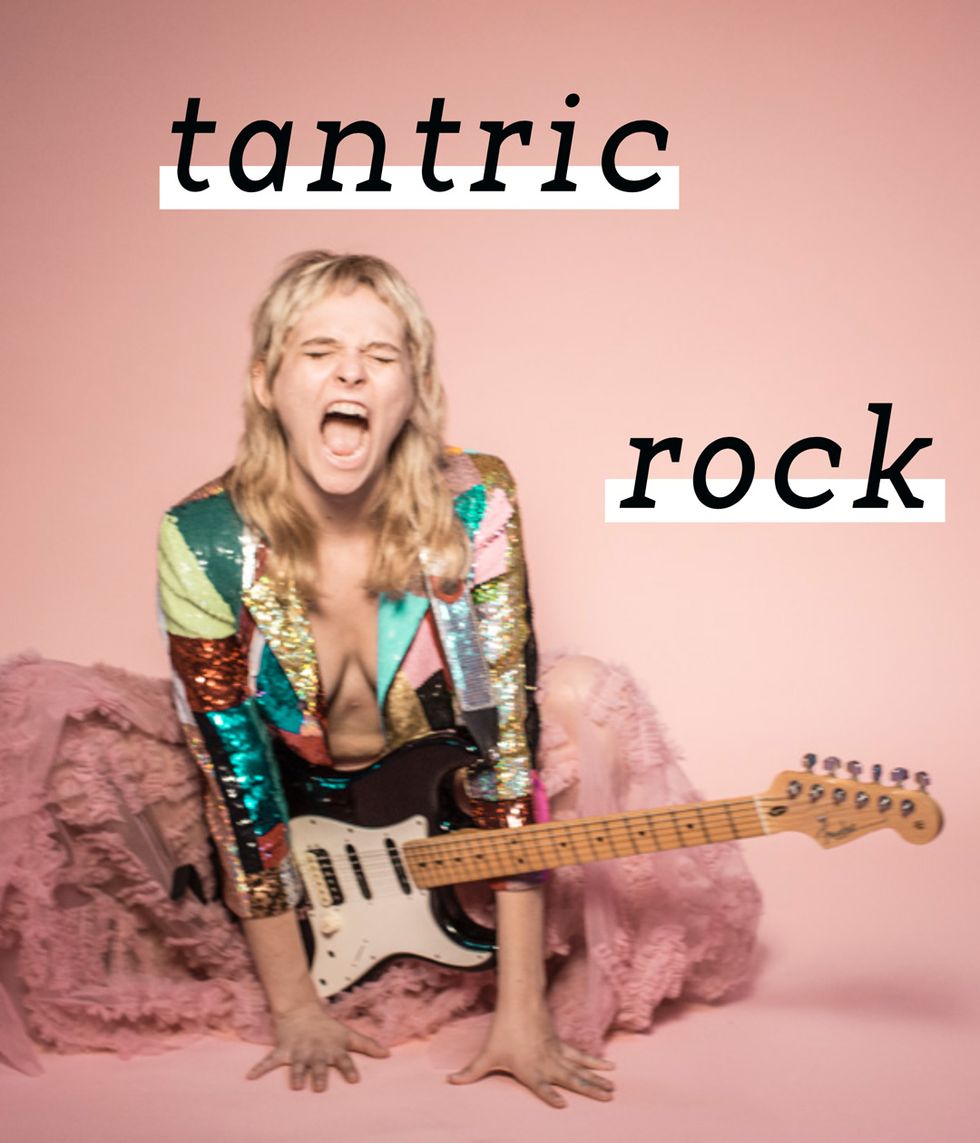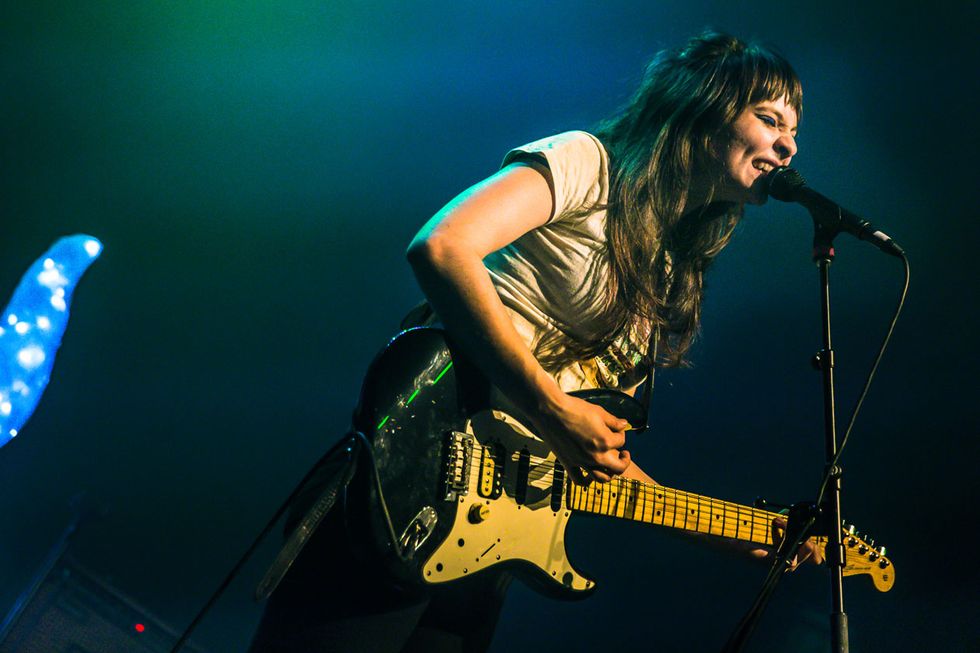“You know what’s funny?” asks Clementine Creevy, in a way that reflects a self-awareness and self-assuredness that seems to transcend her years. “I think for the first time ever, I actually wasn’t surprised when I heard the music that I’d written.” Creevy is referring to the songs on Cherry Glazerr’s new album, Stuffed & Ready, and she adds that the process of writing and recording music was much easier than on previous releases. “I realized that I’ve developed a good ear over the past few years. So, that helped me a lot. I know what I want in the studio now.”
Listening to Stuffed & Ready, it’s evident that the Los Angeles native has evolved and matured musically by leaps since she first wrote, performed, and uploaded a small batch of post-punk, garage-rock songs to SoundCloud in 2012 under the moniker Clembutt, when she was just 15. Those songs quickly caught the attention of Burger Records cofounder Sean Bohrman, who would later release Creevy’s full-length 2014 debut, Haxel Princess, under the moniker Cherry Glazerr, a name inspired by KCRW/NPR radio reporter Chery Glaser, because Creevy thought she had the perfect band name. “It just has a great flow to it,” she says.
Apocalipstick followed in 2017, on indie label Secretly Canadian, and included Creevy’s current drummer Tabor Allen, replacing her high-school friend Hannah Uribe. The album further developed the dark, often-chaotic-yet-melodic sounds unleashed on Haxel Princess.
Pitchfork praised Apocalipstick’s “shredding jams, furious howls, and self-aware swagger”—an apt description for a work by a young, self-empowered, professed feminist eager to share her point of view with the world. Despite the outward heroics, internally, there were growing pains to endure, culminating with the departure of original bassist Sean Redman (now with the Buttertones), who has been replaced by Devin O’Brien. Lineup changes obviously present challenges, but it’s been evident from the band’s inception that Creevy’s confidence, vision, and fiercely idiosyncratic personality are the primary creative forces helming Cherry Glazerr.
For Stuffed & Ready, Creevy started compiling songs while on tour in support of Apocalipstick. “Because we played 200 shows in 2017, I was often writing little bits and pieces on the road,” she explains. “Some stuff came to me in hotel rooms. I’m always playing, on and off the road. And so, I was saving all of these little bits and pieces, all of these weird little links, that were going to become songs.”
When it was time to track, Creevy, Allen, and O’Brien first went to San Francisco, where they cut a batch of songs with producer John Vanderslice at his analog Tiny Telephone Recording. They then took those tunes to producer Carlos de la Garza’s Music Friends studio in Eagle Rock, California, where they really started to hone the material that would become Stuffed & Ready. De la Garza also worked on Apocalipstick, so their familiarity seemed to inspire Creevy. “We work closely with Carlos,” she explains. “And we have similar melodic tendencies, so that comes in handy a lot. We agree on melodies, and that is hard to find.”
“Daddi,” which is in heavy rotation at indie-rock satellite radio channel SiriusXMU, and “Wasted Nun” represent the culmination of those agreed-upon melodic tendencies. They possess a vivid, almost cinematic, intensity forged from Creevy’s musical ideas. Lyrically, Stuffed & Ready is the lens through which Creevy seeks to reconcile her own confusion and anger—an admitted response to the contemporary political climate. “With Apocalipstick, I was an over-confident teenager trying to solve the world’s problems,” she admits. “Now I’m wearier and more cynical. You need to figure your own self out first.” PG recently caught up with Creevy, who was at home in L.A. getting ready for her upcoming tour—which kicked off in Bristol, England, on February 2—for a fast-paced chat that covered a lot of ground, including lessons, gear, and the leitmotifs of her craft.
How do you develop your song ideas?
I always start with a melody that pops into my head. I put it into voice memos, and then I translate that onto the guitar. That’s why I think a lot of our music is kind of riff-oriented. It usually doesn’t happen to me while I’m fiddling around with the guitar. Sometimes it does. But mostly these melodies just pop into my head first, and then I put them down on the guitar. That’s how a lot of my songs started out.
Is there a song on Stuffed & Ready that came out of fiddling around on guitar?
I was in Ohio, and we were doing soundcheck, and the riff from [Stuffed & Ready’s] “Ohio” just came out of me. I bet the venue wanted to fucking kill me, because I made everybody come onstage and play it with me for like an hour. I was just vibing it so hard and just loving it. So, that riff means a lot to me, because I came up with it on the road. It was this very euphoric moment. It starts on this one note, and then it ends at the octave of the same note.
It sounds like there’s a bit of a Black Sabbath influence in there, and in “Distressor,” as well.
I was listening to a lot of Black Sabbath when I wrote those songs—especially “Ohio.” I love playing that riff, because there’s a lot of movement there. It’s killer. I came up with the verse chords after that, which is generally not how I write. But that’s how I did it for “Ohio.”
Did you go into the recording studio with complete songs?
Sometimes it was just a verse and a melody, and Carlos and I would work together on arranging the full song. Then we would put down the vocal melodies and stuff. I think what was cool about this process was how we wanted to keep it simple. Keep it good and keep it simple. So, that’s what we mostly did with the music on this record.
Is Carlos a musician himself?
He is, yeah. He’s mostly a drummer, but he rips on the bass. He’s a shredder.

TIDBIT: John Vanderslice and Carlos de la Garza both worked on the production of Cherry Glazerr’s latest. Of de la Garza, Creevy says, “We agree on melodies, and that is hard to find.”
This is your third album. What have you learned about the recording process?
I think one of the biggest things I learned was how to communicate in the studio. I had picked up so much language throughout my time, both at Carlos’ and at John’s, and at some other studios, but most importantly, I just developed a better ear. I have a better sense of tone and a better sense of production. And so, it really was very exciting. It was like when you learn something new and the world breaks open. That’s what it felt like.
I love when that happens.
It’s so cool. It’s why I play guitar, because it happens all the time with my relationship to the guitar.
When did you start playing guitar?
I got my first guitar when I was 10. My uncle gave it to me. It was a half-size Fender with nylon strings—an acoustic guitar. And I never played it or practiced it [laughs]. So, it didn’t do anything for me for a little bit. And then my mom made me start taking lessons because she thought I had a great sense of rhythm and I was singing all the time. She really wanted me to learn the guitar, because she knew I would have fun with it, and she was right.
What about electric?
I picked up the electric when I was 14. I was listening to a lot of rock music at the time, so it was appropriate. I was also inspired by a lot of funk music that I was listening to. I had just gotten into Bootsy Collins and Sly Stone and Funkadelic. Eddie Hazel was a huge inspiration to me, too.
The funk influence maybe explains why your rhythm playing is so tight. It is a very strong component of your music.
Definitely. I love rhythm. When I started the band, I had this idea that I would be the shredding guitar player in the back, and I would put a singer at the front. I would be like what’s his name, from fucking Radiohead?
Ed O’Brien?
That’s who I would be.
So, what happened? What changed that trajectory?
Well, it didn’t work out. I realized that I really liked how the music sounded with me singing. So, it became clear that I had to be the singer. The voice that matched up to the music best was when I was singing. But I had my friend, Sophia [Muller], singing in the band early on, and she would sing with me. But then it was sad, because I was like, “Don’t sing it like that, sing it like this.” And that was not good for her or me. So, I had to become the singer. And then I realized that I love singing, and that it would be sad if I weren’t singing [laughs].
Besides Radiohead, did you have any other specific guitar influences when you were first learning to play?
I was really into angular punk, too. I love Fugazi, and I would go see No Age and Battles all the time in L.A. I love those two bands.
“I play with a Mesa/Boogie that has this perfect kind of boxy, clean tone that I like,” says Creevy. “I don’t really like when amps break up on their own. And the Mesa/Boogie’s the perfect amp for me because of that.” Photo by Debi Del Grande
When you were recording Stuffed & Ready, did you mix-and-match guitars and amps based on the songs? Or did you stick with a basic stock setup for rhythm tracks?
We mixed and matched everything on every song. We used every amp in there on every song and every guitar on every song. We just stacked and stacked like crazy madmen [laughs].
There are a lot of interweaving guitar parts on the record, so that makes sense. What do you plan to do live? Since Cherry Glazerr is just a trio, are you going to add musicians?
Good question. Well, I’ve got a good rig going, especially with my custom pedalboard. And I play with a Mesa/Boogie that has this perfect kind of boxy, clean tone that I like. I don’t really like when amps break up on their own. And the Mesa/Boogie’s the perfect amp for me because of that. And my Strat is modded, so it’s kind of louder and clearer and tougher. And then I’ve got my pedalboard, with a lot of different distortions. But I also have some guitar tracks that I’ve thrown into the mix.
Guitar tracks, meaning pre-recorded backing tracks?
Yeah.
Okay, cool. So, does Tabor play to a click?
Yeah. He’s played to a click for a few years now. No one seems to notice.
It’s kind of ubiquitous nowadays. People don’t really frown on that kind of thing anymore.
We love our tracks. They’re cool. The tracks are basically parts that I’m playing [on the studio versions], so they just sound huge. It creates this layered effect with my live tone, which is its own special thing. It creates a very cool guitar world, live.
Have you ever had it skip onstage?
No, never. But even if it did, it wouldn’t be that big of a deal. We’d just kill the [pre-recorded] tracks and rip it.
Do you mostly play with a pick?
I play with a pick, yes. Definitely. I don’t understand people who don’t play with a pick. That’s outrageous to me [laughs].
Do you use upstrokes and downstrokes? What’s your right-hand MO?
I use up and downstrokes, for sure. I try to. I’m always trying to better my technique. But I think that for the most part, with my more punk background, I tend to lean more towards downstrokes.
When you say that you work on your technique, do you consciously work on guitar playing skills? Or do you mostly use the guitar as a songwriting tool?
Both. But I do take lessons and I do practice sometimes. Not as often as I should, but before tours and stuff—just to strengthen my hands, mostly.
Do you work on scales and modes and that kind of thing?
Yeah exactly. Just really simple, minor-triad scales and stuff. Stuff that is relevant to me. It’s hard for me to stick to scales, because whenever I pick up the guitar, I write a song—so, that tends to happen. When I should be practicing, I just end up writing a new song [laughs].
But that’s ultimately, the objective, no? To channel practicing into creativity? Isn’t that part of the meditation of practice?
Yeah, that’s a good point. I sometimes feel like I’ve written way more songs than actual practice hours. But yeah, you’re right, of course. It’s like, at the end of the day, I’m lucky enough to be playing big shows. And so, writing songs and having fun with my music is the most important thing to me.
Who do you take lessons from?
I take lessons from Davin Givhan. He plays in a bunch of different bands, but he’s played in Amen Dunes most recently. He’s super great. For years I took lessons from Marc Rey, who I met at the Silverlake Conservatory when I was a teenager. He instilled so much confidence in me as a player and really gave me the tools that I have now. I’m forever indebted to him.
Silverlake Conservatory is Flea’s music school in L.A.?
Yeah, Flea’s school.
How did you like it?
It’s amazing. I love it so much. I heard about it changing locations or shutting down. I don’t know if that happened or not. I haven’t passed by Silverlake in a minute, so I’ll check next time. [Editor’s note: In 2016, the Silverlake Conservatory of Music moved to Hollywood Boulevard in Los Angeles.]

Guitars
Fender American Professional Stratocaster HSS Shawbucker
Amps
’90s Mesa/Boogie Mark IV
Effects
Black Cat Super Fuzz
EarthQuaker Devices Acapulco Gold V2
EarthQuaker Devices Westwood Translucent Drive Manipulator
Keeley Bubble Tron Dynamic Flanger Phaser
Strymon blueSky Reverberator
Strymon Ola dBucket Chorus & Vibrato
Strings and Picks
Ernie Ball Power Slinky (.011–.048)
Dunlop Tortex .73 mm (yellow)
Mogami cable
I read that you took a summer workshop at Musician’s Institute.
I did. It was pretty weird. I don’t know why I did that.
What made it weird?
I think all these kids think they’re going to come to L.A. and they’re going to be famous. Like, they’re going to be playing at the Whisky and the Roxy. And that’s not really how it is here. I wanted to take the class to kind of get put into a competitive scene. And it was certainly competitive, because I was the youngest, by like five years, and I was one of only two women in a class of 100. It was definitely pretty terrifying. But I met my bass player there—my first bass player, Sean Redman.
So, it wasn’t a complete loss.
It was not a complete loss, not at all, no. It was really cool that we met each other there because it was a tough situation. And it was cool that something good came out of it.
You mentioned a Mesa/Boogie amp earlier. What model is it?
It’s a ’90s Mark IV that once belonged to Phantom Planet. I know because their name is on the road case.
Any other essential gear in your setup?
So, I have the Mesa/Boogie, and she is a beast. She’s awesome, I love her so much, and she sounds great. And then, I play with Mogami cables because I have champagne taste when it comes to cables. I also have this crazy little pedal called a Bubble Tron. It’s this kooky flange, but it also does this weird, bubbly sound. It’s hard to describe. It randomly arpeggiates your guitar notes. So, I do that one just for fun, when we’re jamming and stuff.
What about the guitar? You play a Fender Strat, correct?
I have a modded Strat. I ripped out the guts, basically, and all that’s left is a volume knob. To me, it sounds much better, as well as being lighter, which is nice when you tour as much as I do. But mostly, I did it because I don’t use the tone knobs. I was always keeping the guitar on my humbucker pickup. So, I just have one humbucker and a volume knob. And then all the rest of the guts are ripped out. It sounds very cool. It sounds a little bit louder and a little bit tougher and clearer to me.
Even though your sound is distorted, there’s a lot of clarity to it.
Yeah, that’s something I work towards. I think that the guitar is the centerpiece of my music a lot of the time, so I want it to be clear sounding.
I hear you’re kind of notorious for your yellow guitar picks.
It’s really funny, because my drummer, Tabor, for years had no idea that picks were color-coordinated depending on size [gauge]. Because I use medium picks, I’ve always had [Dunlop Tortex .73 mm] yellow ones. A few months ago, he was like, “Man, why do you like the yellow ones so much? Do you just love yellow?” And I was like, “No. You’re such a drummer, no. It’s because they're mediums. They put the medium ones in yellow. I didn’t choose this, it chose me [laughs].”
That’s hysterical.
Yeah, I was so appalled. I was like, “You dirty drummer.” [Laughs.] Just kidding.
You commented earlier about wanting to be a shredder, but your solos are very sparse. They’re more like short musical interludes, rather than bona fide guitar solos. What’s your approach to soloing?
I think when it comes to solos, I like to have a certain element, a tantric element, to them. Some of my favorite solos are Melvins’ solos, and some of those are one-note solos. And I just always thought that was really cool. But the way I write solos is, I’ll record the verse into my phone, and I’ll just have the verse on loop. And then I’ll play a solo to it. My melodic tendency is to just go with a simple melody that goes over the verse part well. And then when you take the verse out, the two of them next to each other can sound really cool. So that’s how I work. I just love things that are beautiful, and I think simplicity can achieve a kind of beauty.
Clementine Creevy performs “Stupid Fish” from Stuffed & Ready live with Cherry Glazerr on KCRW in Santa Monica, California. Check out her typically terse and composed solo right after the 2:00 mark.
















![Rig Rundown: Russian Circles’ Mike Sullivan [2025]](https://www.premierguitar.com/media-library/youtube.jpg?id=62303631&width=1245&height=700&quality=70&coordinates=0%2C0%2C0%2C0)
















![Rig Rundown: AFI [2025]](https://www.premierguitar.com/media-library/youtube.jpg?id=62064741&width=1245&height=700&quality=70&coordinates=0%2C0%2C0%2C0)




















 Zach loves his Sovtek Mig 60 head, which he plays through a cab he built himself at a pipe-organ shop in Denver. Every glue joint is lined with thin leather for maximum air tightness, and it’s stocked with Celestion G12M Greenback speakers.
Zach loves his Sovtek Mig 60 head, which he plays through a cab he built himself at a pipe-organ shop in Denver. Every glue joint is lined with thin leather for maximum air tightness, and it’s stocked with Celestion G12M Greenback speakers.






